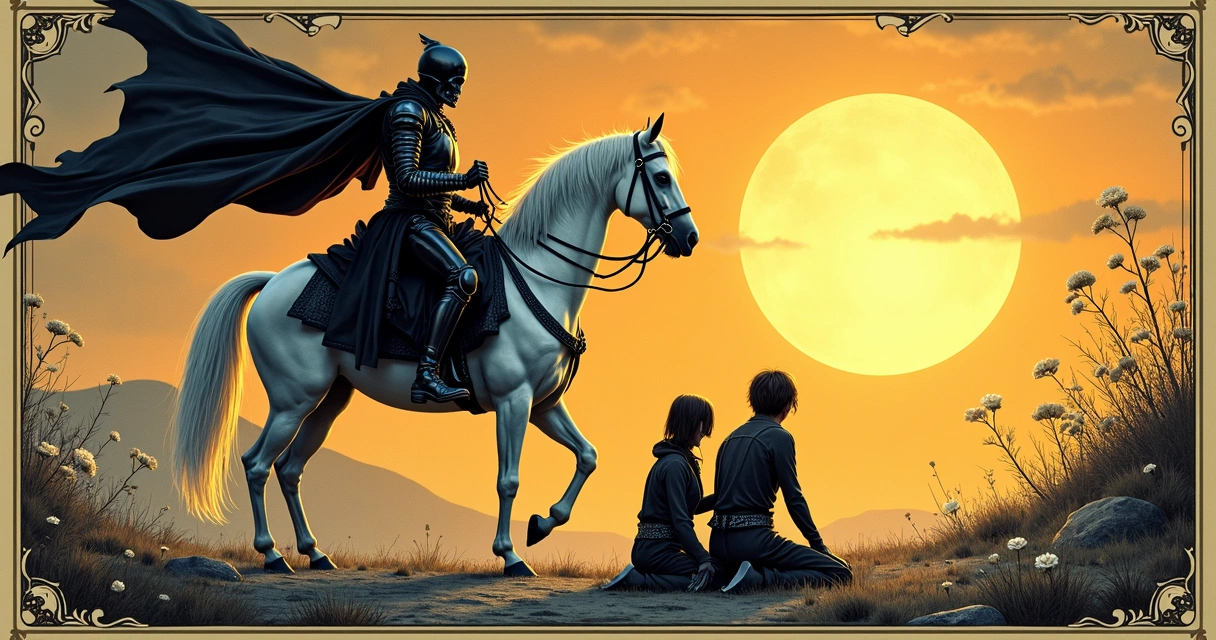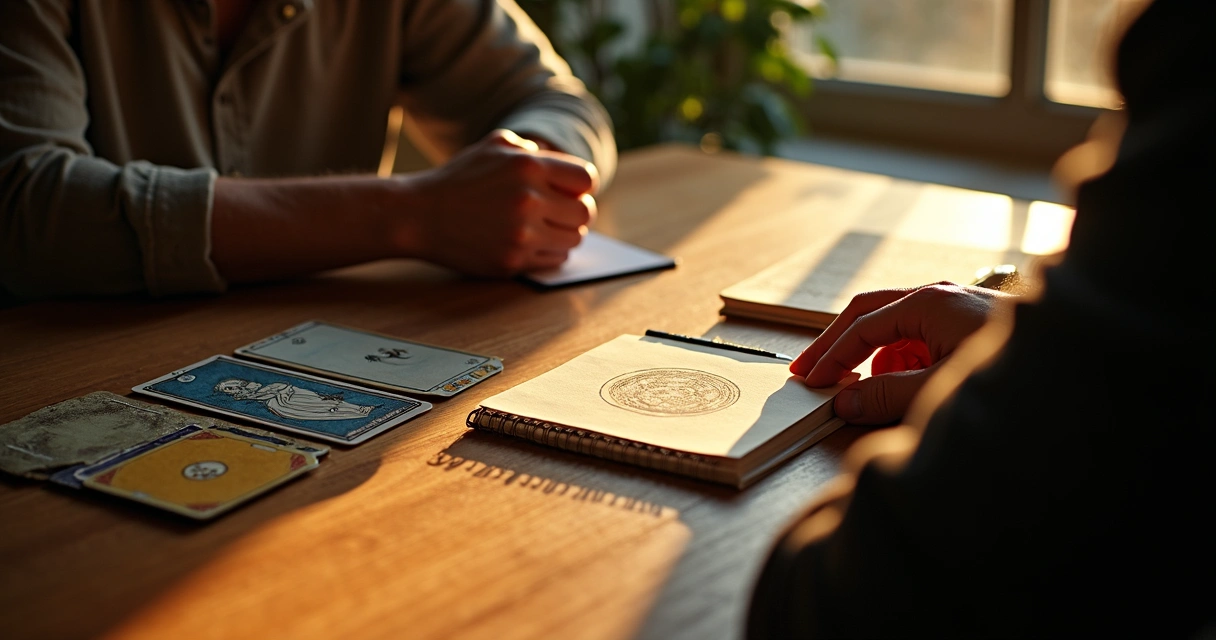Few cards in the tarot spark as many questions or reactions as the Death card. Whether you are laying out cards for a client, reflecting on your own path, or deep in study, the arrival of this card almost always gets a reaction—sometimes a gasp, sometimes a quiet sigh. Yet so much is misunderstood. The skull-faced rider, the fallen crown, the rising sun in the distance: these are less about endings than about the promise on the other side of change.
Death in tarot is about letting go, so something new can begin.
In this article, you’ll find a careful look at the Death card meaning—its upright and reversed interpretations, its symbolism, how it comes alive in readings, and why it’s a central guide during periods of transformation. Whether you consult the tarot professionally or are just getting familiar with tarot’s wisdom with tools like MysticLog, the Death card offers profound lessons on personal growth and renewal.
First impressions and visual symbolism
The iconic image of Death in tarot is impossible to miss. Usually card XIII in the major arcana, it features a skeleton in armor riding a white horse, carrying a black flag with a white five-petaled rose. People kneel or fall around the horse—some helpless, some hopeful.
- Colors: Black armor and banners for what passes away, white horse and rose for purity and newness, golden sun rising on the horizon.
- Symbols:The skeleton: universal symbol of mortality and what is left after everything falls away.
- The white rose: not just beauty, but clarity—purity of intention after change.
- The fallen crown: position, ego, worldly power: none can resist transformation.
- Sunrise: every ending seeds a beginning, even if you cannot see it yet.
- Numerology: 13 is unsettling in some cultures, but in tarot it marks the stage long before completion, nudging you to shed what’s outgrown.
 Every detail invites you to stop and consider—what am I ready to release, and what waits for me on the other side?
Every detail invites you to stop and consider—what am I ready to release, and what waits for me on the other side?
Understanding upright death: change as a gift
Despite its name, the Death card rarely means actual death. Instead, it’s about closing a chapter in order to welcome the next. This is often tough, sometimes even painful, but always necessary for real growth.
- General meaning: The upright Death indicates transformation. Something in your life—be it a relationship, belief, job, or habit—must end for you to move forward. There is honest loss, but there’s also release. In tarot self-reflection, Death signals a process: release, acceptance, rebirth.
- Love: Patterns or partnerships that no longer serve may dissolve. This may stir grief or relief. Sometimes it means letting go so someone better suited can enter your life. For couples, it might mean outgrowing old dynamics, giving space to redefine love on new terms.
- Career: Jobs, roles, or projects wind down—sometimes by choice, sometimes by surprise. Yet, as something closes, your skills and hopes lead you toward better opportunities. Change at work can be intimidating, but Death reminds you to trust the process.
- Finances: Ending a spending habit, releasing a toxic financial agreement, or finally accepting a necessary financial setback. Death brings a clear-eyed assessment, making room for better money choices.
- Spirituality: This is about shedding beliefs or spiritual practices that no longer resonate. With the old gone, space opens for more authentic understanding. Again, it’s not easy, but it’s freeing.
The end is never the end, but a turning page.
The reversed death card: resisting the inevitable
When Death appears reversed, the energy of transformation is blocked or delayed. Maybe you’re clinging to what you know. Maybe fear is stronger than trust. The reversed card is both a warning and a gentle push: move forward, even if it’s hard.
- General meaning: Stagnation, fear of letting go, refusal to accept necessary changes. The old pattern persists, not because it’s good, but because it feels safe. The discomfort can linger until you choose to act.
- Love: Staying in a toxic connection or familiar dynamic simply because change feels lonely or frightening. There may be denial or unresolved grief. The card suggests facing the truth for healing.
- Career: Hanging onto a dead-end job, business, or project. Maybe the fear of uncertainty outweighs your desire for growth. The reversed card prompts honest self-inquiry: “Why am I holding on?”
- Spirituality: Resistance to personal evolution. Doubts creep in, spiritual routines have grown stale, but you struggle to let them go. This card is a call to gentle, but honest, reflection.
 Death as “yes or no”
Death as “yes or no”
When clients ask for a clear yes or no, Death can still offer guidance:
- Yes, if you are ready to let go, embrace change, and trust what’s unfolding.
- No, if you hope to keep everything as it is or resist the shifts called for. The card pushes for honest transformation before desired outcomes can manifest.
The Death card doesn’t always give a simple answer, but it encourages you to lean into change as the surest path forward.
Common misconceptions: does death mean actual death?
It’s natural for people (especially new seekers or anxious clients) to freeze when they see this card. But in almost every reading, the card is not a prediction of physical passings. Instead, it signals:
- An external or internal chapter is closing.
- Something needs to be released for personal or spiritual renewal.
- Growth is possible, but only through letting go.
You are not losing—you are making space for something new.
Professionals using MysticLog find it helpful to review past readings to track how often “endings” really are just beginnings in disguise. With a little perspective, patterns emerge and fear fades.
Card combinations and deeper readings
Context always matters. When the Death card sits beside others, nuance emerges:
- Death and the Fool: A release leads straight into a new adventure. See the Fool’s fresh start for full context.
- Death with Wheel of Fortune: Change is fate, not just choice—cycles turning, as in Wheel of Fortune.
- Death and Ten of Swords: An old story definitively ends—painful, but free from your energy now.
- Death and Ace cards (Cups, Wands, Pentacles, Swords): What you release creates a precise opening: for love, projects, abundance, or clear thinking.
If you want more depth on meanings and combinations, take a look at this full list of tarot card meanings for other cards often paired with Death.
Practical guidance for querents facing change
As a reader, supporting someone through transition is part of your calling. Whenever the Death card turns up, pause. Notice their reaction—take in the story behind their question.
- Name the fear gently: “This card can seem scary, but it almost never predicts an actual death. Instead, it’s about a deep change or release.”
- Encourage reflection: “What feels ready to close in your life? What new possibilities could that open?” Invite journaling—MysticLog shines as a supportive place for these written discoveries.
- Shift the narrative: “Endings are hard, but what if what’s coming is even better?” Even a small question like this, asked softly, can help ease resistance.
- Highlight hope: Point out the sun rising on the card. “The hardest part is often just before the beginning becomes visible.”
 For tarot professionals and learners: deepening your practice
For tarot professionals and learners: deepening your practice
Whether reading for others or studying on your own, you can use the Death card to unlock new insight:
- Keep a log: Track how and when Death appears in your readings using MysticLog. Over time, notice personal cycles of release and renewal. Learning comes in layers.
- Ask gentle questions: Use prompts from resources like self-reflection in tarot to prompt deeper awareness: “What belief am I ready to retire? What possibility have I ignored?”
- Work with meditation: Sit with the card, study its imagery, and let yourself feel its energy—where in your life do you sense the need for a reset?
- Expand your intuition: Sharpen how you read subtle cues using advice from tools like enhancing tarot intuition. The Death card can trigger gut feelings worth exploring.
Transformation is rarely a single event. It is, for most of us, a series of steps: some conscious, some taken for us. In every reading, be patient with both your querents and yourself.
Conclusion: stepping into the next chapter
What feels like an ending is often the beginning you did not know you needed. The Death card, with all its misunderstood mystery, is there to remind you that release is as natural (and necessary) as breath. Through its lessons, you are asked not just to say goodbye—but to say yes to what waits beyond.
If you’re looking to deepen your understanding, keep your past readings organized, or just want a safe place to explore your journey in tarot, give MysticLog a try. Your practice—whether for clients or yourself—deserves space for transformation, too.
Frequently asked questions about the death card
What does the Death card represent in tarot?
The Death card stands for the end of a cycle—a time to release what no longer serves you. It points to deep change and the opportunity for new growth. Most often, it’s about letting go of habits, relationships, beliefs, or situations that have run their course, so you can move forward.
Is the Death tarot card a bad omen?
No, the Death card is not a bad omen. While its depiction can seem frightening, tarot tradition treats this card as a symbol of transformation and renewal. Instead of doom, it signals positive transition—even if the process feels uncomfortable at first.
How can the Death card signal new beginnings?
By clearing space—for example, ending a draining relationship or changing jobs—the Death card readies you for something better. Just as nature renews after things fall away, each ending in your life makes room for a fresh start, often something you could not imagine before.
What should I do if I draw Death?
Pause and reflect. What are you holding onto that maybe it’s time to let go? Ask yourself what you truly want, beyond old habits or situations. Embracing necessary change, even if it’s just one small step, brings you closer to the new chapter the card hints at. If you need support, consider recording your insights and emotions in MysticLog to see your transition more clearly.
Does the Death card always mean physical death?
No, almost never. The Death card in tarot is not a literal message about dying. It’s a metaphor for releasing the old and inviting the new. Think more about transitions—like leaving a role, moving to a new place, or outgrowing a belief—and much less about anything physical.

